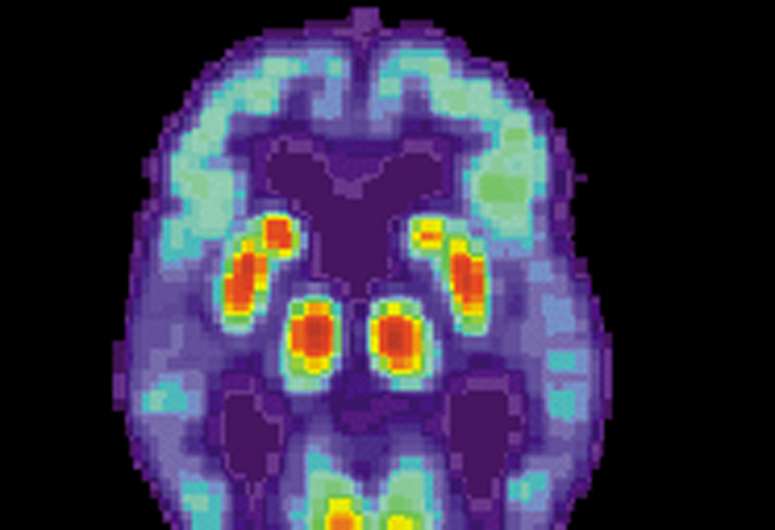PET scan of a human brain with Alzheimer's disease. Credit: public domain
According to a study published in the journal Nature by scientists of the German Center for Neurodegenerative Diseases (DZNE) and the University of Bonn, inflammatory mechanisms caused by the brain's immune system drive the progression of Alzheimer's disease. These findings, which rely on a series of laboratory experiments, provide new insights into pathogenetic mechanisms that are believed to hold potential for tackling Alzheimer's before symptoms manifest. The researchers envision that one day, this may lead to new treatments.
Alzheimer's disease is a devastating neurodegenerative condition ultimately leading to dementia. An effective treatment does not yet exist. The disease is associated with the aberrant aggregation of small amyloid-beta (Abeta) proteins that accumulate in the brain and appear to harm neurons. In recent years, studies have revealed that deposits of Abeta, known as plaques, trigger inflammatory mechanisms of the brain's innate immune system. However, the precise processes that lead to neurodegeneration and progression of pathology have thus far not been fully understood.
"Deposition and spreading of Abeta pathology likely precede the appearance of clinical symptoms such as memory problems by decades. Therefore, a better understanding of these processes might be a key for novel therapeutic approaches. Such treatments would target Alzheimer's at an early stage, before cognitive deficits manifest," says Prof. Michael Heneka, a senior researcher at the DZNE and Director of the Department of Neurodegenerative Diseases and Gerontopsychiatry at the University of Bonn.
An Inflammatory Cascade
Prof. Heneka and coworkers have been investigating the role of the brain's immune response in the progression of Abeta pathology for some time. Previous work by the group published in Nature in 2013 established that the molecular complex NLRP3, which is an innate immune sensor, is activated in brains of Alzheimer's patients and contributes to the pathogenesis of Alzheimer's in the murine model.
NLRP3 is a so-called inflammasome that triggers production of highly pro-inflammatory cytokines. Furthermore, upon activation, NLRP3 forms large signaling complexes with the adapter protein ASC that can be released from cells. "The release of ASC specks from activated cells has so far only been documented in macrophages, and their relevance in disease processes has so far remained a mystery," says Prof. Eicke Latz of the University of Bonn.
In the current study, it was demonstrated that ASC specks are also released from activated immune cells in the brain, the microglia. Moreover, the findings provide a direct molecular link to classical hallmarks of neurodegeneration. "We found that ASC specks bind to Abeta in the extracellular space and promote aggregation of Abeta, thus directly linking innate immune activation with the progression of pathology," Heneka says.
Novel Approach for Therapy?
This view is supported by a series of experiments in mouse models of Alzheimer's disease. In these, the researchers investigated the effects of ASC specks and its component, the ACS protein, on the spreading of Abeta deposits in the brain.
"Additionally, analysis of human brain material indicates at several levels that inflammation and Abeta pathology may interact in a similar fashion in humans. Together, our findings suggest that brain inflammation is not just a bystander phenomenon, but a strong contributor to disease progression," Heneka says. "Therefore, targeting this immune response will be a novel treatment modality for Alzheimer's."
More information: Carmen Venegas et al, Microglia-derived ASC specks cross-seed amyloid-β in Alzheimer's disease, Nature (2017). DOI: 10.1038/nature25158
Journal information: Nature
Provided by German Center for Neurodegenerative Diseases





















